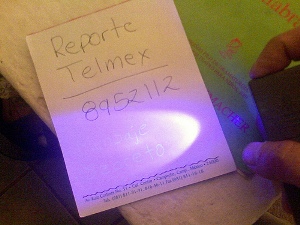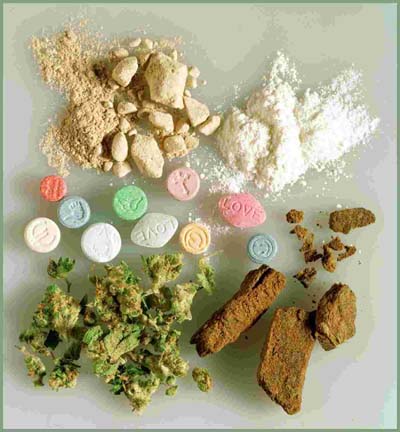Saturday, May 22, 2010
Thursday, May 20, 2010
Thanks To Forensics and Crime Scene Investigation

3 Types of Evidence

Sunday, May 16, 2010
Monday, May 3, 2010
Documentation Protocol
The Interviewing Protocol
Sunday, May 2, 2010
Crime Scene Protocol
Before evidence is collected at a crime scene, there is protocol Investigators must follow. Once the investigator in charge of the crime scene arrives, she should conduct a scene assessment and conduct a scene walkthrough and initial documentation (Knight). The crime scene protocol consists of an interview, examination and documentation of the crime scene, then processing the evidence.
Tuesday, April 27, 2010
Biology Unit

Lastly is the most important biology unit, used to analyze body fluids, DNA, blood factors, hair, fibers, and plant life using biology, biochemistry and microbiology (Delich 3). A very interesting scientist within this unit is a serologist. A serologist studies blood groups and other fluids for classification purposes subsequent to a crime (Kurland 22). Some larger crime laboratories may have units specializing in only photography, toxicology, latent fingerprints, and arson (Delich 3).
Monday, April 26, 2010
Document Analysis Unit

Firearm/Ballistics Unit



Sunday, April 18, 2010
Physical Science Unit
 The Physical science unit is used to examine drugs, soil, glass, blood splatter patterns and other traces of physical evidence using chemistry, physics or geology. In this specific field are geologists, they can determine things such as where the suspect or victim walked by examining soil samples taken from their shoes or feet (Kurland 22).
The Physical science unit is used to examine drugs, soil, glass, blood splatter patterns and other traces of physical evidence using chemistry, physics or geology. In this specific field are geologists, they can determine things such as where the suspect or victim walked by examining soil samples taken from their shoes or feet (Kurland 22).
Wednesday, April 14, 2010
Division of Crime Laboratories
Edmond Locard

“Wherever he steps, whatever he touches, whatever he leaves, even unconsciously, will serve as a silent witness against him. Not only his fingerprints or his footprints, but his hair, the fibers from his clothes, the glass he breaks, the tool mark he leaves, the paint he scratches, the blood or semen he deposits or collects. All of these and more bear mute witness against him. This is evidence that does not forget. It is not confused by the excitement of the moment. It is not absent because human witnesses are. It is factual evidence. Physical evidence cannot be wrong, it cannot perjure itself, and it cannot be wholly absent. Only human failure to find it, study and understand it can diminish its value.”
Edmund Locard is well known for his famous principle, “Every contact leaves a trace.” Locard’s exchange principle is also referred to as Locard’s Theory which was established in 1904. Six years after Locard’s theory was established, he became the director of the first crime laboratory in existence in
Tuesday, April 13, 2010
Karl Lansteiner
Landsteiner identified the human blood groups which are still to this day A, B, AB, and O. He was awarded The Nobel Peace Prize 1930 for his work.
Tuesday, March 30, 2010
The Dry Evidence Room
Friday, March 26, 2010
My Mentor

Elizabeth Love!!!!
Thursday, March 25, 2010
Alphonse Bertillon & Edward Henry


Alphonse Bertillon a Frenchman was the first to create a method use for criminal identification. His system was solely based on the classification of skeletal body measurements and characteristics. Bertillon’s method was based only on eleven bodily measurements as well as eye color, hair, and the skin. His classification was adopted by France in 1888. The difficulties of Bertillon’s system made it hard to profile and identify criminals, therefore, a new identification method needed to be created. Fingerprinting became available in the early 20th century (Holtyman).
Argentina was the first country to replace the Bertillon system of measurements with fingerprints when Juan Vucetich solves a murder using bloody fingerprints. In 1896 Edward Henry develops the prototype fingerprint classification system now used in the United States and Europe(Deslich 5).With the establishment of this new system in 1902 Harry Jackson a burglar becomes the first Englishmen to be convicted solely on the basis of fingerprints(Deslich 6).
Wednesday, March 24, 2010
The Father of Toxicology

Tuesday, March 23, 2010
Brief History of Forensic Science
 The impression of forensic science in the world and its development in the United States has grown along with technology. The 12th was the period in which criminal investigations in the United States was initiated and later became a very important part of solving crime. King Richard I of England created the job of the coroner to further examine disputed deaths. As the population increased in urban areas so did crime. As time went on and cold cases began to stack up, it soon became clear that specialists in medical advancements were needed. Massachusetts was the first state to implement this idea. Later many states in the long run adopted the idea .As time progressed, so did technology. Before forensics was ever developed as a whole more and more crimes were committed. A group of devoted law enforcement personnel were and are now recognized as Forensic Scientist or Criminologist. They are very educated, experienced individuals that know a substantial amount in the method of scientific techniques, collecting and analyzing physical evidence in criminal cases.
The impression of forensic science in the world and its development in the United States has grown along with technology. The 12th was the period in which criminal investigations in the United States was initiated and later became a very important part of solving crime. King Richard I of England created the job of the coroner to further examine disputed deaths. As the population increased in urban areas so did crime. As time went on and cold cases began to stack up, it soon became clear that specialists in medical advancements were needed. Massachusetts was the first state to implement this idea. Later many states in the long run adopted the idea .As time progressed, so did technology. Before forensics was ever developed as a whole more and more crimes were committed. A group of devoted law enforcement personnel were and are now recognized as Forensic Scientist or Criminologist. They are very educated, experienced individuals that know a substantial amount in the method of scientific techniques, collecting and analyzing physical evidence in criminal cases.











